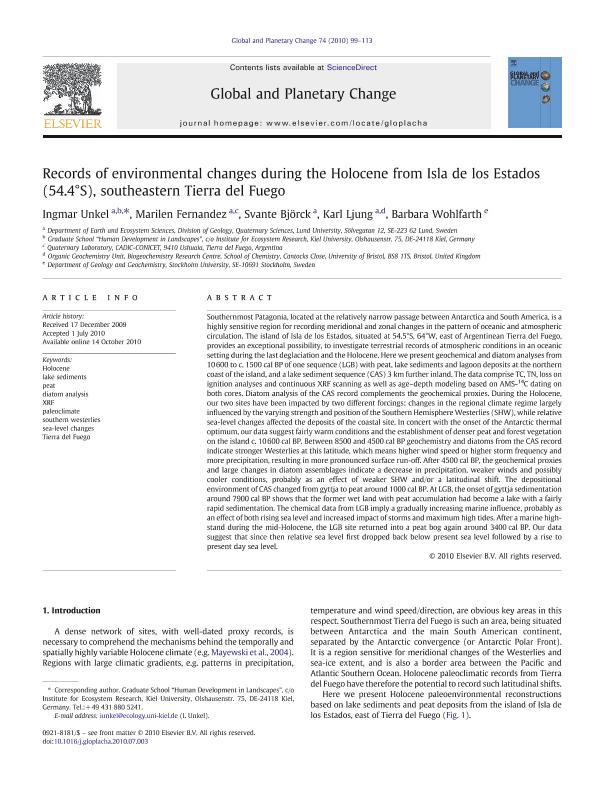Mostrar el registro sencillo del ítem
dc.contributor.author
Unkel, Ingmar
dc.contributor.author
Fernández, Marilén

dc.contributor.author
Björck, Svante
dc.contributor.author
Ljung, Karl
dc.contributor.author
Wohlfarth, Barbara
dc.date.available
2017-02-07T20:36:13Z
dc.date.issued
2010-12
dc.identifier.citation
Unkel, Ingmar ; Fernández, Marilén; Björck, Svante ; Ljung, Karl; Wohlfarth, Barbara ; Records of environmental changes during the Holocene from Isla de los Estados (54.4°S), southeastern Tierra del Fuego; Elsevier Science; Global And Planetary Change; 74; 3-4; 12-2010; 99-113
dc.identifier.issn
0921-8181
dc.identifier.uri
http://hdl.handle.net/11336/12693
dc.description.abstract
Southernmost Patagonia, located at the relatively narrow passage between Antarctica and South America, is a highly sensitive region for recording meridional and zonal changes in the pattern of oceanic and atmospheric circulation. The island of Isla de los Estados, situated at 54.5°S, 64°W, east of Argentinean Tierra del Fuego, provides an exceptional possibility, to investigate terrestrial records of atmospheric conditions in an oceanic setting during the last deglaciation and the Holocene. Here we present geochemical and diatom analyses from 10 600 to c. 1500 cal BP of one sequence (LGB) with peat, lake sediments and lagoon deposits at the northern coast of the island, and a lake sediment sequence (CAS) 3 km further inland. The data comprise TC, TN, loss on ignition analyses and continuous XRF scanning as well as age–depth modeling based on AMS-14C dating on both cores. Diatom analysis of the CAS record complements the geochemical proxies. During the Holocene, our two sites have been impacted by two different forcings: changes in the regional climate regime largely influenced by the varying strength and position of the Southern Hemisphere Westerlies (SHW), while relative sea-level changes affected the deposits of the coastal site. In concert with the onset of the Antarctic thermal optimum, our data suggest fairly warm conditions and the establishment of denser peat and forest vegetation on the island c. 10 600 cal BP. Between 8500 and 4500 cal BP geochemistry and diatoms from the CAS record indicate stronger Westerlies at this latitude, which means higher wind speed or higher storm frequency and more precipitation, resulting in more pronounced surface run-off. After 4500 cal BP, the geochemical proxies and large changes in diatom assemblages indicate a decrease in precipitation, weaker winds and possibly cooler conditions, probably as an effect of weaker SHW and/or a latitudinal shift. The depositional environment of CAS changed from gyttja to peat around 1000 cal BP. At LGB, the onset of gyttja sedimentation around 7900 cal BP shows that the former wet land with peat accumulation had become a lake with a fairly rapid sedimentation. The chemical data from LGB imply a gradually increasing marine influence, probably as an effect of both rising sea level and increased impact of storms and maximum high tides. After a marine high-stand during the mid-Holocene, the LGB site returned into a peat bog again around 3400 cal BP. Our data suggest that since then relative sea level first dropped back below present sea level followed by a rise to present day sea level.
dc.format
application/pdf
dc.language.iso
eng
dc.publisher
Elsevier Science

dc.rights
info:eu-repo/semantics/openAccess
dc.rights.uri
https://creativecommons.org/licenses/by-nc-nd/2.5/ar/
dc.subject
Holocene
dc.subject
Lake Sediments
dc.subject
Peat
dc.subject
Diatom Analysis
dc.subject
Xrf
dc.subject
Paleoclimate
dc.subject
Southern Westerlies
dc.subject
Sea Level Changes
dc.subject
Tierra del Fuego
dc.subject.classification
Geología

dc.subject.classification
Ciencias de la Tierra y relacionadas con el Medio Ambiente

dc.subject.classification
CIENCIAS NATURALES Y EXACTAS

dc.title
Records of environmental changes during the Holocene from Isla de los Estados (54.4°S), southeastern Tierra del Fuego
dc.type
info:eu-repo/semantics/article
dc.type
info:ar-repo/semantics/artículo
dc.type
info:eu-repo/semantics/publishedVersion
dc.date.updated
2017-02-07T18:03:08Z
dc.journal.volume
74
dc.journal.number
3-4
dc.journal.pagination
99-113
dc.journal.pais
Países Bajos

dc.journal.ciudad
Ámsterdam
dc.description.fil
Fil: Unkel, Ingmar . Lund University; Suecia. Kiel University. Institute for Ecosystem Research; Alemania
dc.description.fil
Fil: Fernández, Marilén. Consejo Nacional de Investigaciones Científicas y Técnicas. Centro Austral de Investigaciones Científicas; Argentina. Lund University; Suecia
dc.description.fil
Fil: Björck, Svante . Lund University; Suecia
dc.description.fil
Fil: Ljung, Karl. University of Bristol; Reino Unido. Lund University; Suecia
dc.description.fil
Fil: Wohlfarth, Barbara . Stockholms Universitet; Suecia
dc.journal.title
Global And Planetary Change

dc.relation.alternativeid
info:eu-repo/semantics/altIdentifier/url/http://www.sciencedirect.com/science/article/pii/S0921818110001542
dc.relation.alternativeid
info:eu-repo/semantics/altIdentifier/doi/http://dx.doi.org/10.1016/j.gloplacha.2010.07.003
Archivos asociados
